Overtaking Fundamentals: Action packed 2022 F1 season?
JANUARY 24, 2022
Written by Rowland Jowett
Perhaps the most exciting aspect of an F1 race is the tension surrounding an overtake. Over the years, F1 regulations have been shaped by the governing body and teams in an attempt to improve the spectacle. Historically, ad hoc analysis has been carried out by the teams to determine whether a particular modification to the rules would yield a positive impact. With new simulation technologies from Canopy Simulations, we are eager to find out whether the wake reduction caused by the 2022 aero regulations will result in an enhancement in on track action. In this article we shall present the results of tens of thousands of simulated overtakes to get a sneak preview.
The Bad Old Days
I have been involved in such overtaking investigations in the past while running the driver-in-loop simulator for a top F1 team. The driver is given a new car, inline with the proposed regulations, and spends time getting up to speed. When a good laptime has been established, this is saved off as a ghost lap. The grip is turned up slightly to give a pace differential, and the driver attempts to overtake the ghost car. The ease by which the driver can overtake is then compared to a familiar baseline car overtaking a baseline ghost lap.
The experiment sounds relatively straightforward, but the process is fraught with difficulties. As is the nature of F1, the baseline car is usually a finely honed specimen taken from a race debrief, so jumping into a modified car requires a great deal of setup work to rebalance it, along with changes to the toys (electronic devices on the car, such as differential, brake by wire, engine braking), and driver familiarisation time. Before you know it, quarter of a day has passed and you have a comparison of just two different cars.
Next comes the painful process of trawling through the data to determine the overtaking advantage. Overtakes are usually sparse events, and it is prudent not to read too much into an individual overtake when drawing conclusions which have a bearing on the future of the sport. The downside to this is that without plenty of laps available to pore over there is an over reliance on driver opinion.
This leaves the results open to interpretation, and without meaning to cast aspersions, the powers that be might have their own agenda when it comes to modifying the regulations to play to the particular strengths of their team rather than the enjoyment of the sport.
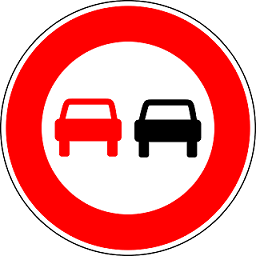
The Future
Fortunately Canopy Simulations have streamlined the entire process of making objective decisions regarding overtaking performance by producing a cloud based simulation tool. The driver has been removed from the process, and the ghost lap is set by running Dynamic Lap, which varies the brake-throttle-steer and racing line position around the lap in order to produce the optimal laptime.
Overtaking Lap, based on the same collocation engine, is used to chase down and overtake the Dynamic Lap. The collocation objective for Dynamic Lap is minimum laptime, whereas Overtaking Lap has been rewired to achieve a clean overtake.
The advantages of using a simulation instead of a driver are:
Multiple car configurations can be tested on parallel computers.
A statistical approach to overtaking can be taken by analysing tens of thousands of attempts to overtake, a process which would give a human driver double vision and a migraine.
Bias can be removed; Overtaking Lap doesn’t have an opinion or agenda when it comes to the future of the sport!
The driver in loop simulator can then be used to verify the overtaking advantage of the most promising candidates, rather than spending months sifting through all of the options.
Since this approach is revolutionary, we couldn’t resist performing our own investigation into what really drives overtaking in the form of an overtaking fundamentals study.
Traditional Fundamentals Study
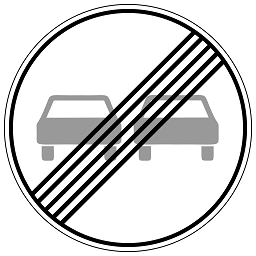

Sensitivity to mass: how laptime varies as mass is changed.
A common simulation task performed by racing teams is a fundamentals study. This highlights the laptime sensitivity to mass, power, downforce, grip and other car parameters. The sensitivity assists engineers in making trade-offs when it comes to car design. For example, a designer might look at reducing the size of the airbox to get an improvement in aerodynamics at the expense of engine power. By using the headline figures for sensitivity of laptime to aero and power they can quickly assess whether the trade gains more from aero than it loses in power. Ultimately, for a decision this important it would be prudent to simulate both cars, but designers frequently make minor decisions about car design, which together contribute to car performance. Individually these decisions are not worth pestering the simulation engineer for a precise laptime, so having these rules of thumb to hand allows for a sensible estimate.
Along a similar vein, we wondered what fundamental aspects of an F1 car would make for better (more frequent) overtaking. We believe this overtaking fundamentals study is a world first, and looks at the sensitivity of overtaking performance to mass, power, downforce, wake and grip. The hope is that we no longer have to speculate about what fundamental changes would improve overtaking. The analysis was performed at Austin. This Tilke designed circuit is a greatest hits compilation of other tracks, and features opportunities to overtake as well as high speed sections where following closely can be challenging [could Tillke have done an even better design if he had access to Overtaking Lap?].
Sensitivity to Mass

10 different starting positions around the lap.
Starting with an F1 car setup, the stiffness is increased so that the mass of the attacking and defending car can be varied simultaneously between 500kg and 1500kg (regulatory without fuel = 775kg). At each point in the study, the overtaking car is set off at 10 different starting positions around the lap, at 17 grip levels. The number of cars at each grip level that successfully make the overtake is used to generate the probability that an overtake is made for any given grip advantage. The overtaking metric used here is the pace delta that gives a 20% chance of an overtake per lap (i.e. 2/10 cars at that grip level managed to overtake).
The reason for increasing the grip on the attacking car is because outside of the first lap it is relatively rare for cars with the same pace to overtake, usually an overtake occurs because one car has a pace advantage, perhaps by the way of better tyres (more grip) but potentially other differences (aero, power etc). Grip serves as a reasonable proxy for providing this pace differential. As the grip differential is increased eventually all cars make an easy pass. The better the car is at overtaking, the less you have to turn the grip up to help it pass.
For convenience the grip advantage is displayed as an equivalent pace delta by simulating how much quicker that car would be in clean air; instead of talking about a car needing, say, 3% more grip to overtake, it is easier to think of that car being 1.2sec a lap faster.
From thousands of attempts to overtake at different mass and grip levels, our sensitivity of overtaking performance to vehicle mass is constructed:
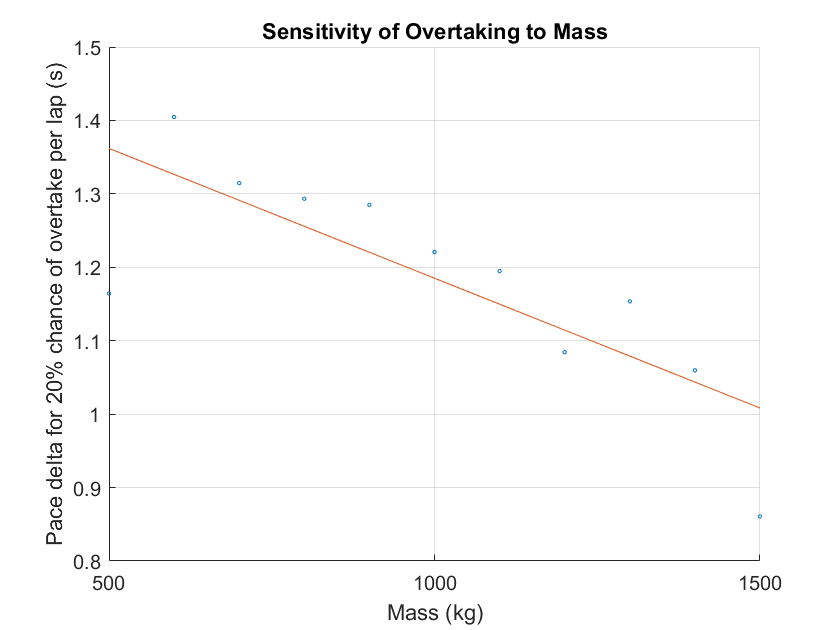
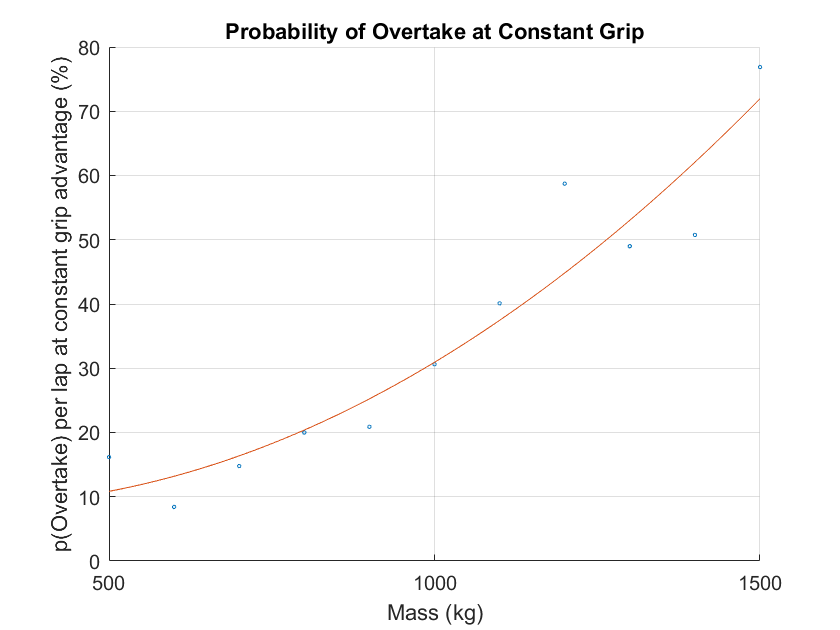
At the baseline car mass of 800kg, for a 20% chance of overtake per lap, the left hand graphs shows that the following car needs a 1.26sec per lap pace advantage. While the absolute numbers might not correlate perfectly with reality, or model some of the heroic passes made by drivers, the importance of this study is to assess the relative overtaking merits of different car configurations i.e. what changes can make the cars fundamentally better at overtaking. The surprising observation here is that despite the deep-rooted obsession with lightweight performance cars, the heavier cars actually find it easier to pass one another. If, heaven forbid(!), the mass grew to 1000kg, then the following car would only need a 1.19sec laptime advantage to complete the manoeuvre.
To put this in perspective, the right hand graph shows what the probability of an overtake looks like when all overtaking cars have exactly the same grip (rather than varying the grip to achieve a 20% chance of overtake as per the left hand graph). If the car mass were to be increased from 800kg to 1000kg, the chance of an overtake per lap rises from 20% to 31%. That is an awful lot more on track action for the sake of giving the gram-counting car designers a few months on holiday.
Sensitivity to Power
Part of the excitement of going to see an F1 race is to witness the speed and hear the symphony from the powerful engines. Engine manufacturers don’t publish power figures, but once the MGUK is added, the total power is somewhere in the region of 1000bhp. What would happen to overtaking if engine power was reduced?
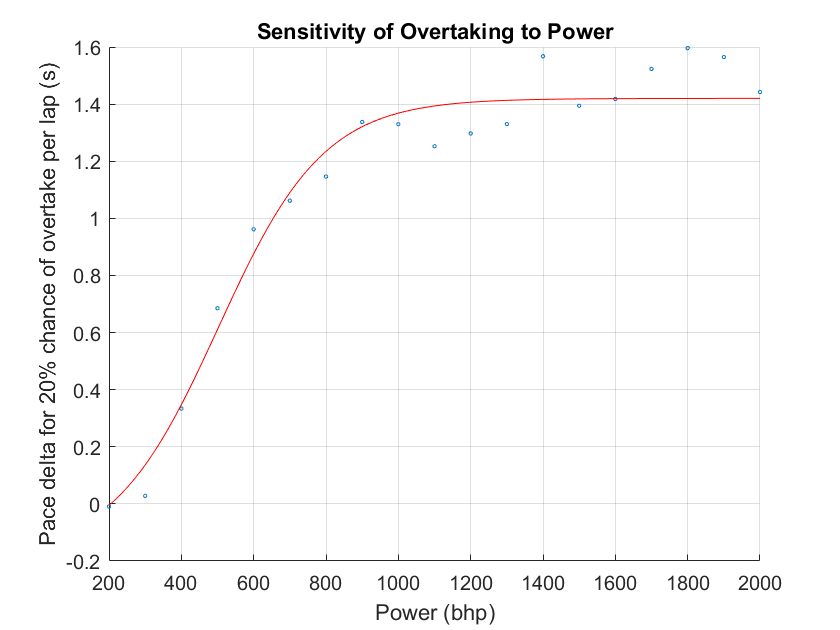
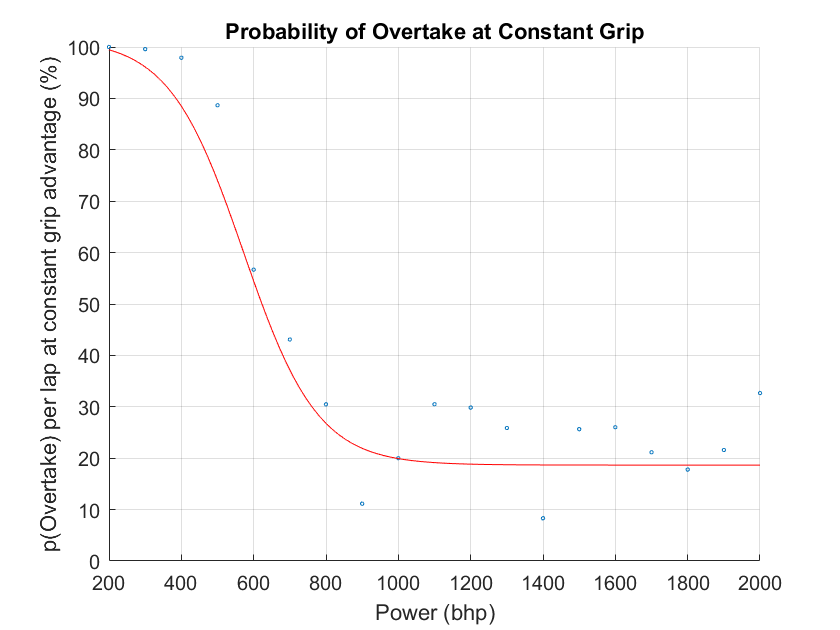
Between 900bhp and 2000bhp the sensitivity to power is relatively flat, however, below 700bhp there are some significant gains in overtaking performance. At 500bhp the pace differential required to complete an overtake is less than half that required for full powered cars, and the probability of an overtake shoots up from 20% to 74%.
I feel like a traitor for even contemplating a drop in power output, but it is fair to say that there are plenty of lower powered racing series that deliver a lot of excitement.
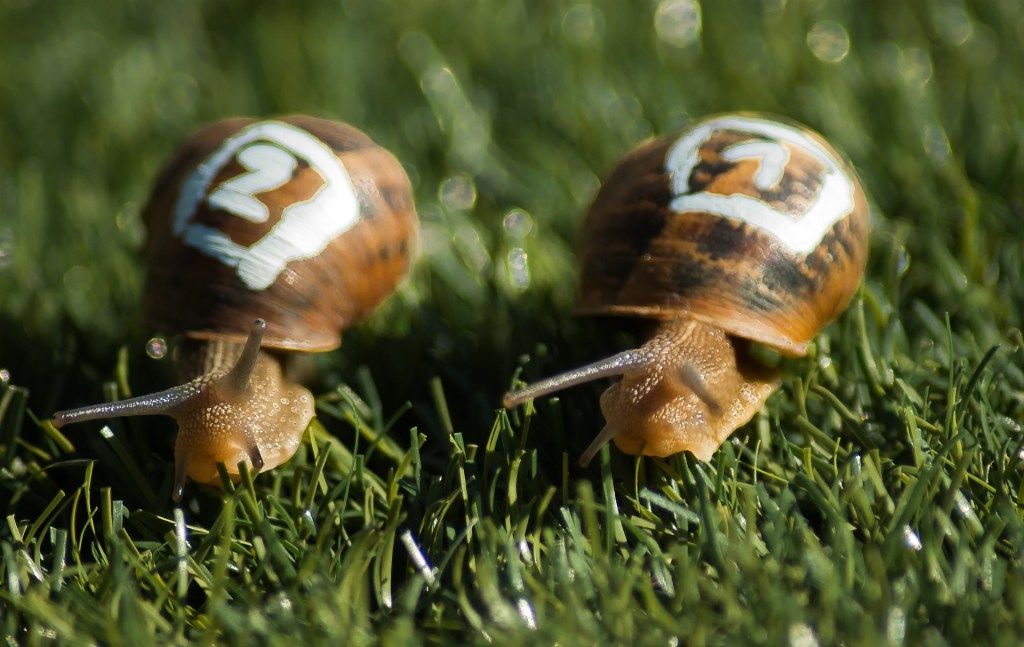
Sensitivity to Downforce
Downforce and drag are swept from 100% (the level of an F1 car) to 26% downforce and 38% drag (the level of an FE car) and in the opposite direction by extrapolating on the same gradient. One of the benefits of simulation is that it allows you to test things that aren’t physically possible. This sweep is done without changing the aerodynamic wake produced by the car ahead. This isn’t physically realistic as the turbulent air would likely diminish as downforce level drops. For this study it is interesting to look at the effect of downforce and wake independently. The results from a pure downforce sweep at iso-wake looks very compelling:
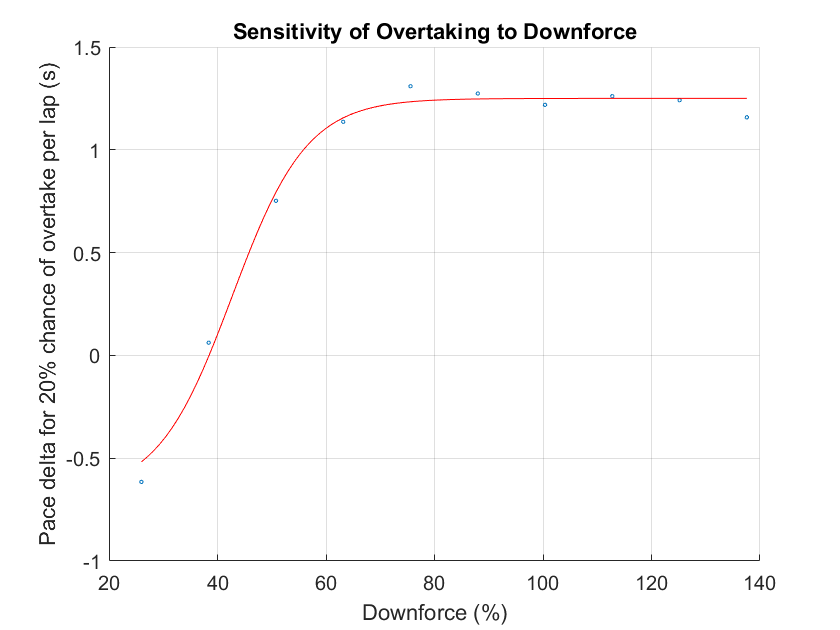
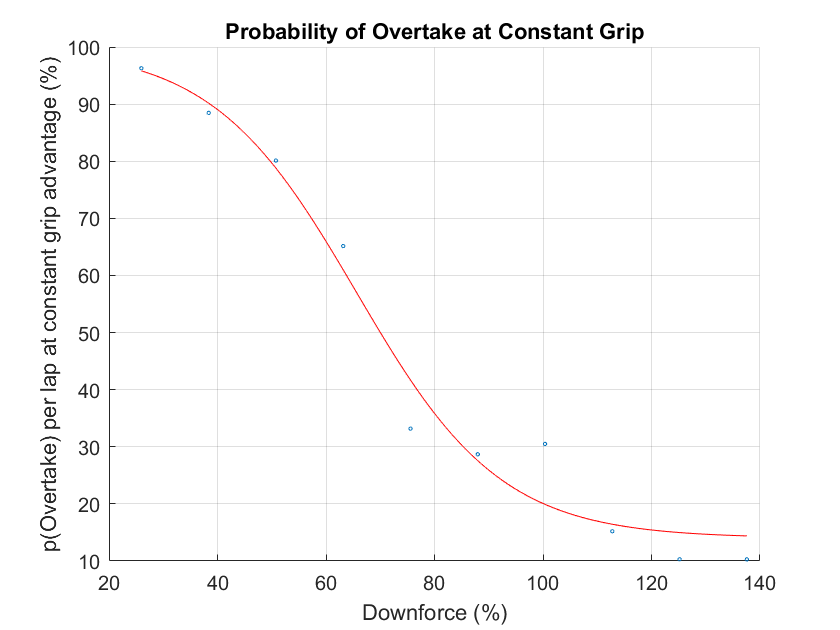
The improvement in overtaking ability as all cars drop downforce and drag level is remarkable. A drop to 50% reduces the required pace delta from 1.26sec to 0.75sec, and the probability of an overtake at a constant grip advantage increases from 20% to 80%. Going further in the direction of dropping downforce results in the attacking car being able to overtake without additional grip. This is before taking into account the effect that a reduction in downforce would have on the wake.
Sensitivity to Wake
The overtaking car has to contend with the aerodynamic wake left by the lead car and this has led to extensive hand wringing and debate among those exercised by the lack of overtaking spectacle. The predicted wake numbers are published on formula1.com:

Formula 1 reduction in downforce loss from the dirty air with 2022 regulations.
At one car length behind the 2021 car there is a downforce drop of 46% (with a corresponding drag decrease of 23%). The regulation changes made for the 2022 car are designed specifically to reduce this catastrophic downforce loss, and CFD estimates that this downforce loss should be reduced from 46% to just 18% in 2022.
Overtaking Lap models the wake behind the lead car with these values of initial downforce loss. The wake then widens and dissipates to zero as the distance behind the lead car increases. The magnitude and duration of the wake is scaled to look at the improvement in overtaking performance as predicted by the CFD numbers from the table:
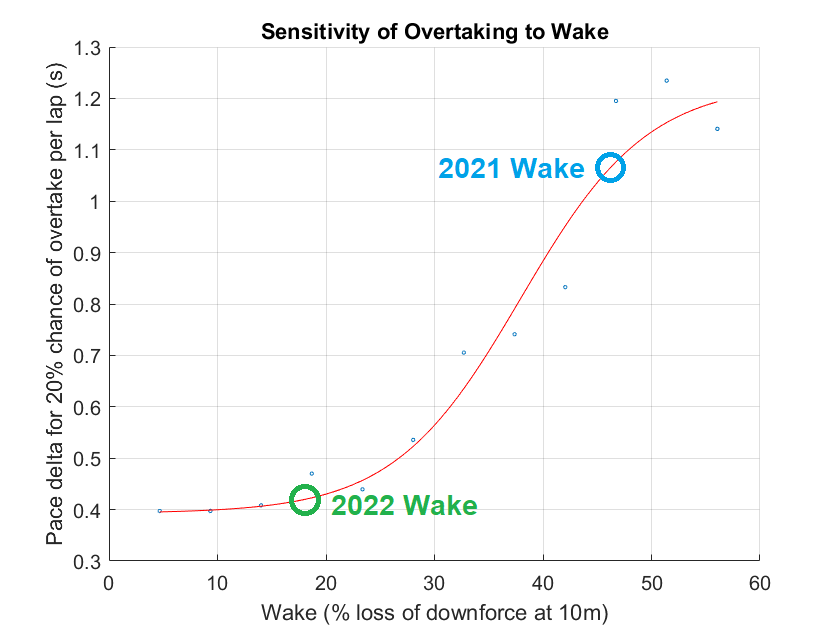
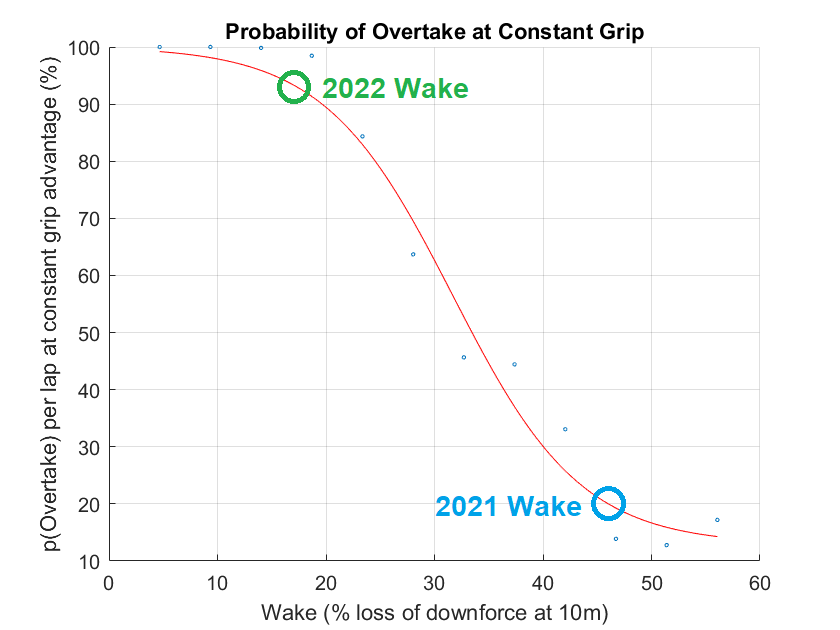
Reducing the wake has a powerful effect on the overtaking performance. The 2021 car requires a 1.06sec pace advantage to have a 20% chance of an overtake per lap, which reduces to just 0.42sec with the 2022 CFD numbers. This is a remarkable improvement; if the following 2021 car had a 20% chance of overtaking, this should be increased to 92% in 2022.
The regulation changes are clearly targeting a very sensitive aspect of car overtaking performance. If the CFD predicted aerodynamic wake reduction materialises on track we should brace ourselves for a sensational season. However, previous attempts to limit the performance of teams have been thwarted by the smart engineers onboard who are highly motivated by a predictable 1–2 finish, so it remains to be seen what clever tricks they have up their sleeves this year.
Sensitivity to Grip
If there is one thing that delivers tension during a race, it’s a drop in traction, be it through tyres wearing out or rain on the track. Here we look at the effect of grip drop.
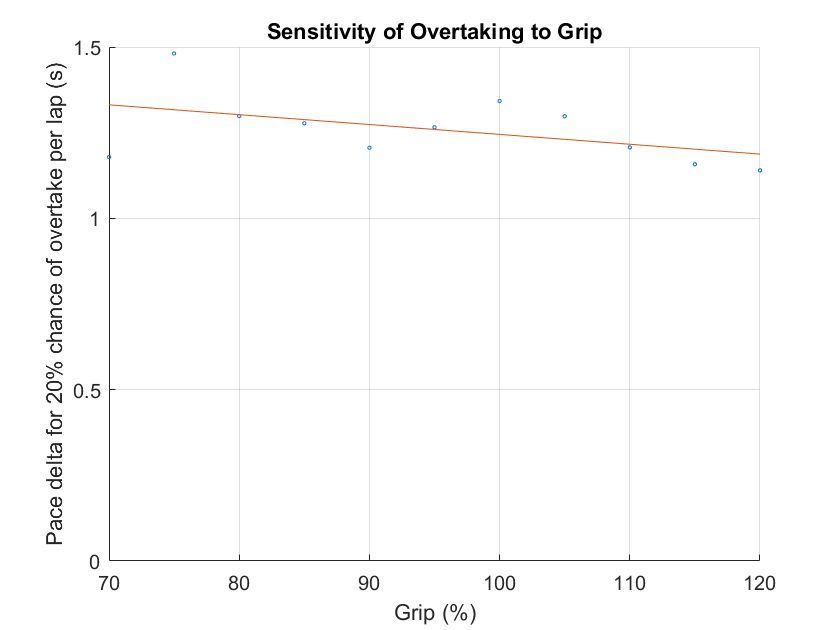
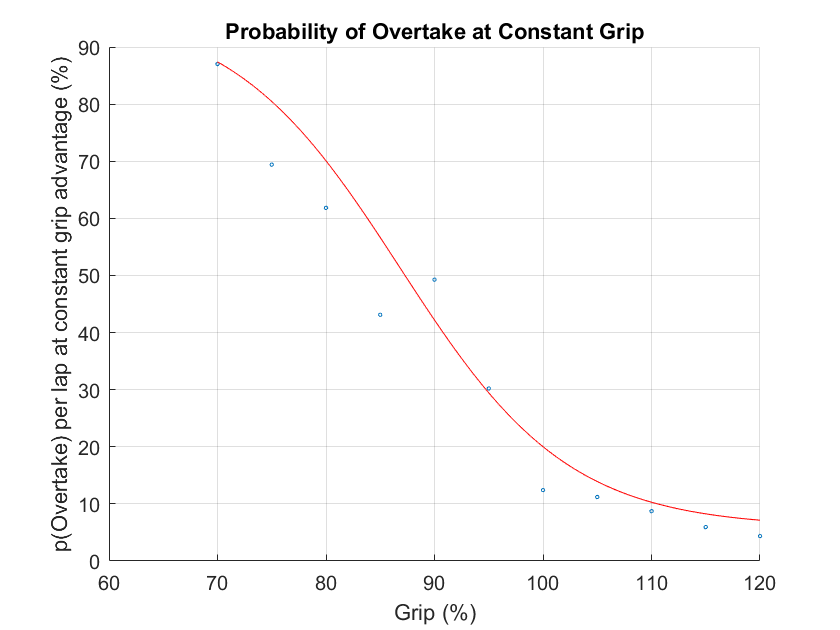
At first glance these two graphs appear to be contradictory. The right hand graph shows that below 100% grip, the probability of an overtake increases significantly, while the left hand graph shows that the pace delta required to make that pass increases slightly. There is a good reason for this small increase. When teams compute the regular laptime sensitivities as part of a regular fundamentals study, they find that the car is most sensitive to grip, and the laptimes tumble when grip is dropped. In other words, if a racing team could magically select one of the following: 1% more grip, 1% more power, 1% more downforce or 1% less mass, they would take the grip every time. This high grip sensitivity means the car with 70% grip is setting pedestrian laptimes of 2m01sec, compared to the baseline of 1m41sec. It is relatively easy to find 1.3sec of pace delta when you’re chugging around 20sec slower, so the graphs do agree: it is easier to overtake when the cars have less grip.
The Ultimate Prescription for a Great Show
If we want to improve the spectacle, what fundamental changes should be made to improve overtaking? The sacrilegious view is that F1 cars should be less like F1 cars; low downforce, low power, high mass and low grip. Alex at Canopy recently wrote an article about The Heart of F1; surely we can’t be suggesting that we break this. Perhaps the answer is to target the most promising areas, but to do this we need some way to compare the relative merits of each fundamental change. Let’s look at the local sensitivities: how much does the % chance of an overtake change when we change each fundamental parameter by 1%.
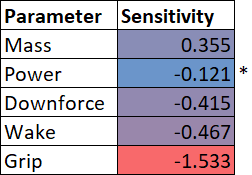
% change in overtaking probability per % change in each parameter.
Immediately grip comes out as the most sensitive parameter. A 10% drop in grip for both cars would improve the chance of quicker car making a pass by over 15.33%. This suggest that tyres should be low grip, and variable, because you still need a pace delta to stir up the running order. Looking back to the end of the Michelin era, we saw very consistent grippy tyres that could sometimes last the whole race distance. Unfortunately this meant you could usually turn your TV off after the final pit stop (or sometimes even the first lap).
The mass sensitivity might suggest that the obsession with lightweight F1 cars might not be well founded. If there is an exciting new technology on the horizon that would add weight to the car, maybe this shouldn’t be considered as a downside.
*The power sensitivity has been highlighted with an asterisk because despite a small reduction only showing a marginal gain in overtaking, a much larger decrease really starts to improve things. F1 cars are currently operating on the flatter part of the curve, giving a low headline figure for power sensitivity, however below 700bhp the odds of an overtake really start to ramp up, and at 200bhp (shudder the thought!) the simulation shows cars overtaking each other without a pace advantage. Therefore while the headline figure for power sensitivity is low, a significant reduction actually causes a large improvement in overtaking.
It is not surprising to see aerodynamic effects as the joint second most sensitive parameters when it comes to preventing overtakes. The downforce sweep was performed with a constant wake, meaning that when taking the additional wake into account, the problem is compounded; downforce and wake would likely reduce together, perhaps doubling the overall effect. Depressingly, F1 cars seem to be close to the worst possible level of downforce for allowing overtakes, with an increase hardly making matters worse, while a reduction shows a strong improvement.
A sufficiently large reduction in wake appears to be highly effective. Fortunately, the 2022 regulation changes are aimed at providing just that. The formula1.com published CFD numbers show a wake reduction from 46% to 18%, and if this reduction in dirty air materialises at the track, the pace differential required for a 20% chance of overtake reduces from 1.06sec to just 0.42sec.
Conclusion
This study simulates the effect that multiple fundamental car parameters have on overtaking performance, providing an objective view of how regulation changes could be applied to increase the level of on track action.
Grip has the most powerful effect, but it is quite hard to influence without major changes to the sport.
The current power level of F1 cars seems to make it difficult for cars to pass. Halving the power has a massive effect, but conversely increasing the power doesn’t seem to make matters worse.
Heavy cars seemingly overtake each other with relative ease compared to super lightweight machines.
Even before taking the turbulent air into account, high levels of downforce seem to have a detrimental effect.
Wake is the low hanging fruit that can be influenced without changing the fundamentals of F1, which makes it a sensible parameter for the FIA to target.
The 2022 regulation changes aggressively target the turbulent wake and our simulations show that this should result in an exhilarating season. Failing that, I can’t wait to tune in for a special showdown of Hamilton versus Verstappen in low powered trucks, preferably in the snow.
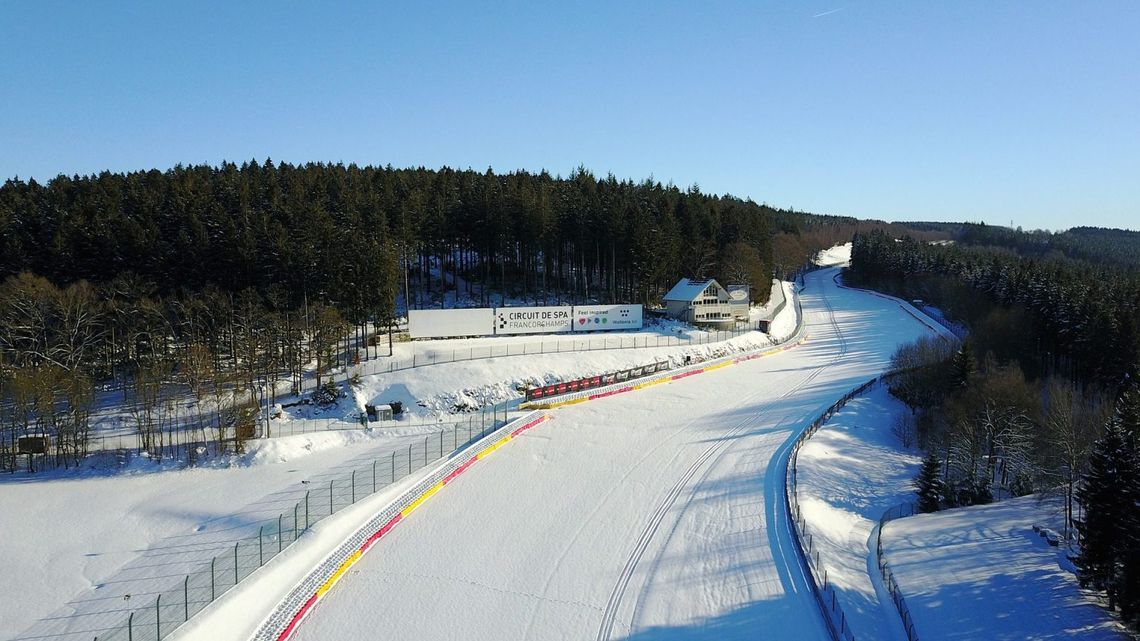
Spa in perfect condition
Stay tuned for part 2 where we will attempt to understand the mechanisms behind these trends. Why does low grip result in more action?